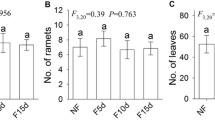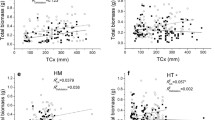Abstract
The capacity of small clonal fragments to survive and grow is a major factor in the spread of clonal plants, especially aquatic species. This study of the introduced, invasive, amphibious, stoloniferous herb Alternanthera philoxeroides in China tested the effects of fragment size, of loss of the stolon apex, and of the original position of a fragment within a clone before fragmentation on the survival and growth of fragments in a greenhouse experiment. The stolon internodes of plants consisting of one stolon with 5 ramets were severed in all 16 possible patterns, generating fragments of 1–5 ramets. These 16 fragmentation treatments were crossed with removal of the stolon apex. Fragmentation and apex removal did not affect total growth of plants, but more highly fragmented plants produced smaller, more numerous ramets. The survival of fragments consisting of one original ramet was about 85%, compared to 100% survival of fragments with 5 original ramets. Fragments consisting of the youngest ramets along the original stolon grew more than fragments of the same size that consisted of older ramets. These effects of fragmentation on growth provide new evidence for clonal integration of the rate at which connected ramets produce new ramets and novel evidence that fragments produced from different portions of clones have different potential for spread. They further suggest that detachment of small groups of distal ramets along stolons in the field might be very effective in spreading the species and that a trade-off between the number and the size of new ramets produced by fragments may represent an adaptive, plastic response to disturbance. Results do not recommend intentional fragmentation of clones as a means of controlling the rate of growth of this invasive species but suggest that incidental fragmentation may not increase its growth in mass, although it may increase its rate of spread.





Similar content being viewed by others
References
Alpert P (1996) Nutrient sharing in natural clonal fragments of Fragaria chiloensis. J Ecol 84:395–406
Barrat-Segretain MH, Bornette G (2000) Regeneration and colonization abilities of aquatic plant fragments: effect of disturbance seasonality. Hydrobiologia 421:31–39
Bimova K, Mandak B, Pyšek P (2003) Experimental study of vegetative regeneration in four invasive Reynoutria taxa (Polygonaceae). Plant Ecol 166:1–11
Birch CPD, Hutchings MJ (1994) Exploitation of patchily distributed soil resources by the clonal herb Glechoma hederacea. J Ecol 82:653–664
Cabaço S, Alexandre A, Santos R (2005) Population-level effects of clam harvesting on the seagrass Zostera noltii. Mar Ecol Prog Ser 298:123–129
D’Hertefeldt T, Jónsdóttir IS (1999) Extensive physiological integration in intact clonal systems of Carex arenaria. J Ecol 87:258–264
De Kroon H, Kalliola R (1995) Shoot dynamics of the giant grass Gynerium sagittatum in Peruvian Amazon floodplains, a clonal plant that does not show self-thinning. Oecologia 101:124–131
Di Carlo G, Badalamenti F, Jensen A, Koch E, Riggio S (2005) Colonisation process of vegetative fragments of Posidonia oceanica (L.) Delile on rubble mounds. Mar Biol 147:1261–1270
Dong BC, Yu GL, Guo W, Zhang MX, Dong M, Yu FH (2010a) How do internode length, position and presence of leaves affect survival and growth of Alternanthera philoxeroides after fragmentation? Evol Ecol 24:1447–1461
Dong BC, Zhang MX, Alpert P, Lei GC, Yu FH (2010b) Effects of orientation on survival and growth of small fragments of the invasive, clonal plant Alternanthera philoxeroides. Plos One 5:e13631
Dugdale TM, Clements D, Hunt TD, Butler KL (2010) Alligatorweed produces viable stem fragments in response to herbicide treatment. J Aquat Plant Manag 48:84–91
Geng YP, Pan XY, Xu CY, Zhang WJ (2006) Phenotypic plasticity of invasive Alternanthera philoxeroides in relation to different water availability, compared to its native congener. Acta Oecolog 30:380–385
Going B, Simpson J, Even T (2008) The influence of light on the growth of watercress (Nasturtium officinale R. Br.). Hydrobiologia 607:75–85
Gonzáles-Teuber M, Gianoli E (2008) Damage and shade enhance climbing and promote associational resistance in a climbing plant. J Ecol 96:122–126
Guo H, Mazer SJ, Du GZ (2010) Geographical variation in seed mass within and among nine species of Pedicularis (Orobanchaceae): effects of elevation, plant size and seed number per fruit. J Ecol 98:1232–1242
Holm LG, Doll J, Holm E, Pancho J, Herberger J (1997) World weeds: natural histories and distribution. Wiley, New York
Jia X, Pan X, Li B, Chen J, Yang X (2009) Allometric growth, disturbance regime, and dilemmas of controlling invasive plants: a model analysis. Biol Invasions 11:743–752
Julien MH, Bourne AS (1986) Compensatory branching and changes in nitrogen content in the aquatic weed Salvinia molesta in response to disbudding. Oecologia 70:250–257
Julien MH, Skarratt B, Maywald GF (1995) Potential geographical distribution of alligator weed and its biological control by Agasicles hygrophila. J Aquat Plant Manag 33:55–60
Klimeš L, Hendriks R, van Groenendael J (1997) Clonal plant architecture: a comparative analysis of form and function. In: de Kroon H, van Groenendael J (eds) The ecology and evolution of clonal plants. Backhuys, Leiden, pp 1–29
Klimešová J, Kocianová A, Martinková J (2008) Weeds that can do both tricks: vegetative versus generative regeneration of the short-lived root-sprouting herbs Rorippa palustris and Barbarea vulgaris. Weed Res 48:131–135
Latzel V, Klimešová J (2009) Fitness of resprouters versus seeders in relation to nutrient availability in two Plantago species. Acta Oecolog 35:541–547
Liu C, Yu D (2009) The bud and root sprouting capacity of Alternanthera philoxeroides after over-wintering on sediments of a drained canal. Hydrobiologia 623:251–256
Ma RY, Wang R (2005) Invasive mechanism and biological control of alligatorweed, Alternanthera philoxeroides (Amaranthaceae), in China. Chin J Appl Environ Biol 11:246–250
McPhee C, Bonser S, Aarssen L (1997) The role of apical dominance in the interpretation of adaptive architecture in prostrate plant species. Ecoscience 4:490–500
Okada M, Grewell BJ, Jasieniuk M (2009) Clonal spread of invasive Ludwigia hexapetala and L. grandiflora in freshwater wetlands of California. Aquat Bot 91:123–129
Pan XY, Geng YP, Sosa A, Zhang WJ, Bo L, Chen JK (2007) Invasive Alternanthera philoxeroides: biology, ecology and management. Acta Phytotaxonomica Sinica 45:884–900
Puijalon S, Piola F, Bornette G (2008) Abiotic stresses increase plant regeneration ability. Evolut Ecol 22:493–506
Rivera M, Scrosati R (2008) Self-thinning and size inequality dynamics in a clonal seaweed (Sargassum lapazeanum, Phaeophyceae). J Phycol 44:45–49
Sainty G, McCorkelle G, Julien M (1998) Control and spread of alligator weed Alternanthera philoxeroides (Mart.) Griseb., in Australia: lessons for other regions. Wetl Ecol Manag 5:195–201
Stuefer JF, Huber H (1999) The role of stolon internodes for ramet survival after clone fragmentation in Potentilla anserina. Ecol Lett 2:135–139
Stuefer JF, van Hulzen JB, During HJ (2002) A genotypic trade-off between the number and size of clonal offspring in the stoloniferous herb Potentilla reptans. J Evol Biol 15:880–884
Truscott AM, Soulsby C, Palmer SCF, Newell L, Hulme PE (2006) The dispersal characteristics of the invasive plant Mimulus guttatus and the ecological significance of increased occurrence of high-flow events. J Ecol 94:1080–1091
Wang B, Li W, Wang J (2005) Genetic diversity of Alternanthera philoxeroides in China. Aquat Bot 81:277–283
Wang N, Yu FH, Li PX, He WM, Liu FH, Liu JM, Dong M (2008) Clonal integration affects growth, photosynthetic efficiency and biomass allocation, but not the competitive ability, of the alien invasive Alternanthera philoxeroides under severe stress. Ann Bot 101:671–678
Wang N, Yu FH, Li PX, He WM, Liu J, Yu GL, Song YB, Dong M (2009) Clonal integration supports the expansion from terrestrial to aquatic environments of the amphibious stoloniferous herb Alternanthera philoxeroides. Plant Biol 11:483–489
Wilson JRU, Yeates A, Schooler S, Julien MH (2007) Rapid response to shoot removal by the invasive wetland plant, alligator weed (Alternanthera philoxeroides). Environ Exp Bot 60:20–25
Wright JT, Davis AR (2006) Demographic feedback between clonal growth and fragmentation in an invasive seaweed. Ecology 87:1744–1754
Xie D, Yu D, Yu LF, Liu CH (2010) Asexual propagations of introduced exotic macrophytes Elodea nuttallii, Myriophyllum aquaticum and M. propinquum are improved by nutrient-rich sediments in China. Hydrobiologia 655:37–47
Xu CY, Schooler SS, Van Klinken RD (2010) Effects of clonal integration and light availability on the growth and physiology of two invasive herbs. J Ecol 98:833–844
Ye WH, Li J, Cao HL, Ge XJ (2003) Genetic uniformity of Alternanthera philoxeroides in South China. Weed Res 43:297–302
Yu FH, Wang N, Alpert P, He WM, Dong M (2009) Physiological integration in an introduced, invasive plant increases its spread into experimental communities and modifies their structure. Am J Bot 96:1983–1989
Acknowledgments
We thank Guo-Lei Yu, Wei Wu and Huan Li for research assistance. This study was supported by the Forestry Commonwealth Project (Grant 201004078), the Fundamental Research Funds for the Central Universities (Grant JC2011-4), the Specific Programs in Graduate Science and Technology Innovation of Beijing Forestry University (Grant BLYJ201104), and the External Cooperation Program of the Chinese Academy of Sciences (Grant GJHZ0904). This material was based in part on work supported by the U.S. National Science Foundation, while working at the Foundation, but does not necessarily reflect the views of the Foundation.
Author information
Authors and Affiliations
Corresponding author
Rights and permissions
About this article
Cite this article
Dong, BC., Alpert, P., Guo, W. et al. Effects of fragmentation on the survival and growth of the invasive, clonal plant Alternanthera philoxeroides . Biol Invasions 14, 1101–1110 (2012). https://doi.org/10.1007/s10530-011-0141-5
Received:
Accepted:
Published:
Issue Date:
DOI: https://doi.org/10.1007/s10530-011-0141-5




